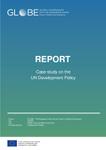The Missing Link? Regional Organizations and the Sustainable Development Goals
The 2030 Agenda for Sustainable Development of the United Nations (UN) constitutes the most important UN sustainable development agenda for the next decade. It is known for its far-reaching and ambitious vision with its 17 goals and 169 targets. More importantly, the Agenda marks a new approach in the UN governance model as it embraces and further develops “governance through goals”, building on the Millennium Development Goals.
This “governance through goals” approach, or goal-setting model, can be considered a form of global experimentalist governance and has implications for each actor’s role and relations in global governance. In the report, we focus on regional organizations and analyze their (actual and potential) role as important intermediaries between the UN and the member states in the goal-setting model of global governance of the SDGs. We focus on the role of two specific regional organizations: the European Union (EU) and the Association of Southeast Asian Nations (ASEAN). In research on the SDGs, regional organizations have not received much attention. Indeed, there seems to be a dismissal of the role of regional organizations because of the global and country-led character of the SDGs. In fact, within the vast scholarly literature on the SDGs, most research heavily focuses on the evolution, theories, debates, and practices of sustainable development governance at the global level, on individual countries’ implementation and on implementation of specific goals of the SDGs. Yet, regional organizations can contribute, in various ways, to the achievement of the SDGs.
We argue that the role of regional organizations is currently underdeveloped and could be strengthened in the context of the global SDG agenda. This focus is especially important in the context of the GLOBE project, which aims to investigate trends in global governance and the role of the EU therein. Our overall argument starts from the observation that the SDG agenda constitutes a relatively new form of global governance which resembles a global experimentalist governance model, revolving around global goal-setting and country-level (member state) implementation. For such a governance model to work, its architecture or institutional design is crucial and involves many different actors on multiple levels of governance. Each actor in the design has an important role to play. Such a global goal-setting framework should not be a loose, soft or voluntary system but needs sufficient dynamic accountability and reporting mechanisms between different levels to achieve goals. In such an architecture, regional organizations play a potentially important role since they can strengthen the implementation of the goals through different governance roles.
In order to analyze the role of regional organizations in the SDG framework, the paper develops an analytic framework based on four roles that regional organizations can play in global governance. First, regional organizations can play a translating role in which they operationalize goals and targets into concrete policies. Second, they can offer a supporting role for the implementation of goals by providing different forms of additional capacity including operational capacity, bridging capacity and knowledge capacity. Third, they can play a coordinating role between member states in order to align policies. Fourth, regional organizations can play a monitoring and progress-reporting role which can be used to benchmark progress and create an upward dynamics in achieving the SDGs.
We apply this framework to the current roles played by the EU and ASEAN in the SDGs. In our analysis, we identify different institutional mechanisms developed by the EU and ASEAN which we summarize in Table 1. We find significant differences in how the two regional organizations engage with the SDGs framework, which can mainly be explained by their different regional contexts and institutional designs. Yet, we also argue that the role of the EU and ASEAN in the governance of the SDGs is underdeveloped and could be strengthened, especially in a context in which progress towards achieving the SDGs is slow. In particular, the two regional organizations could potentially play a more important role in supporting the implementation and coordination of the SDGs. This stronger coordination function could lead to learning effects between member states of the regional organizations.
Table 1: Roles of the EU and ASEAN in goal-setting model for the SDGs
|
Role |
European Union |
ASEAN |
|
|
Translating role |
No explicit SDG strategy |
Complementarity Initiative linking ASEAN Vision 2025 and 2030 Agenda |
|
|
Supporting role |
|
|
|
|
Coordinating role |
Horizontal coordination within the regional organization |
|
|
|
Vertical coordination |
|
|
|
|
Monitoring role |
|
|
|
In sum, we identify several shortcomings and, from this analysis, we distil recommendations for the EU and ASEAN to strengthen their engagement with the SDG agenda, which we discuss in forthcoming blogs.
From a global governance perspective, we argue that the current approach of the SDG framework constitutes an incomplete (experimentalist) design with insufficient interactions between different levels of governance, especially between the level of the regional organization and the level of the member states. This design could be strengthened.
Authors: Charline Depoorter (KUL), Michiel Hoornick (KUL), Axel Marx (KUL), Tirta Nugraha Mursitama (BINUS), Kari Otteburn (KUL), Sukmawani Bela Pertiwi (BINUS), Lili Yulyadi (BINUS)
